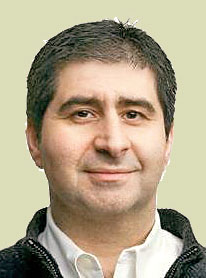After a much-hyped CEO search following Steve Ballmer’s retirement announcement, Microsoft picked a long-time insider, Satya Nadella, paired with cofounder Bill Gates to lend assistance. The rationale for the pick made a lot of sense, with Microsoft being a difficult culture to penetrate, a complex multi-part business, and one that is still financially performing well, despite intensifying challenges on all fronts along with missteps in mobile and self-inflicted wounds in the PC space.
The selection of an insider after a prolonged search reminded me of the 1970s Pina Colada song (“Escape,” by Rupert Holmes). Bored in his relationship with his wife, the singer puts an ad in the paper looking for companionship. After arranging to meet the woman who responds with similar interests at a restaurant, he finds that it is his wife! The happy ending of rediscovery in the song might resemble more optimistic times to come for Microsoft, if the trajectory set by Mr. Nadella’s first few months on the job continues.
Office for iPad
It was rumored that Microsoft Office for iPad was ready more than a year before it actually shipped. It only shipped after Nadella took the helm, and in a couple of short months it has been downloaded over 27 million times. The product has truly met pent-up demand from both businesses and consumers who also use PCs in serious ways.
Microsoft Office is not without its competitors, and leaving iPad users to habituate to the competition has not been wise. Microsoft likely calculated that supporting the iPad would have harmed Windows 8 tablet adoption. The reality is that Windows 8 harmed the adoption of PCs, and now that Office for iPad is selling in big volumes, it will help users re-invest in PCs, because the sit-down experience on a PC with a large screen, a human-sized keyboard and a high-precision mouse is still unparalleled in productivity to any tablet for most knowledge-worker jobs. Pulling the trigger on Office for iPad might have been in the works anyway, but it happened on Nadella’s watch.
Desktop back in business
At Build 2014, Microsoft announced significant new Windows updates, some now released and some still to come, which amount to a restoration of the strategic status of the desktop to Microsoft. While never declared dead or “legacy,” the environment suffered from significant under-investment as Microsoft launched its tablet interface.
The reaction of the user base was decisive, and Microsoft quickly went back to the drawing board to re-reimagine tablet and desktop convergence. The new vision essentially acknowledges the strategic longevity of the desktop for sit-down users by allowing PCs to be configured and sold as primarily desktop machines and by allowing desktop users to run Windows Store apps effectively within re-sizeable windows and with better mouse support. The desktop becomes a superset machine that more effectively hybridizes the two interface realms. Again, this has been in the works, but it was announced on Nadella’s watch.
Upping the ante in open source
One stunning surprise announcement made at Build 2014 was the open-sourcing of the latest version of the .NET compiler, code-named Roslyn, along with 23 other developer technologies. Microsoft is creating a foundation to manage the projects, and it has invited contributors such as long-time partner Xamarin.
While Microsoft has been engaged in open source for a variety of interoperability technologies, this is by far the most significant body of open-source code it has ever released, and it signals an additional shift in stance away from the highly antagonistic approach the company took with Linux a decade ago.
(Related: Microsoft open-sources ASP.NET on GitHub)
Microsoft it also progressively broadening its developer tools and runtimes to appeal to developers across multiple ecosystems. Its work to integrate Web technologies like JavaScript as first-class citizens in the Windows Store app model, its integration of TFS with Git, and its work with Xamarin to ease multi-platform application development are evidence points that support a broader realignment narrative that is accelerating under Nadella’s leadership.
The Microsoft Azure cloud
Microsoft’s efforts in the cloud, which had their inception in the “software-and-services” initiative of 2005, predate not only the CEO transition but also Mr. Nadella’s leadership of the Server and Tools Division. The vision for Azure was always an OS in the cloud, and so finding ways to run all Windows workloads was a natural R&D agenda.
But until early 2013, Microsoft’s vision was to recruit newly developed workloads and not to compete full-bore on the IaaS side. Mr. Nadella was instrumental in changing this during his reign at Server and Tools, and he accelerated a massive spending spree to build one of the most extensive data center networks in the industry, ready to run any and all workloads.
As CEO, Mr. Nadella has the opportunity to reap the fruits of this strategy, and the incredible pace of development has only accelerated with the recent TechEd announcements. Two important indicators of this broadening shift are dropping “Windows” from Microsoft Azure (thus signaling the multi-platform approach; more than 25% of the instances running custom workloads on Azure are Linux), and promoting developer-beloved executive Scott Guthrie to head Azure. Guthrie has been one of the most pragmatic and positive communicators for Microsoft technologies to the broader developer world and an internal force of customer advocacy. A new world where multi-platform no longer means multiple versions of Windows is upon Microsoft.
Perception is reality
The saying goes that perception is reality and reality is perception, and Microsoft is trying hard to change the perception of the company. As it succeeds in changing this perception, it is potentially creating progressively more ambitious internal goals for true change. Microsoft’s customers and its ecosystem will be the biggest beneficiaries of this change.
Al Hilwa is program director of application development software research at IDC. Follow him on Twitter at @alhilwa.






